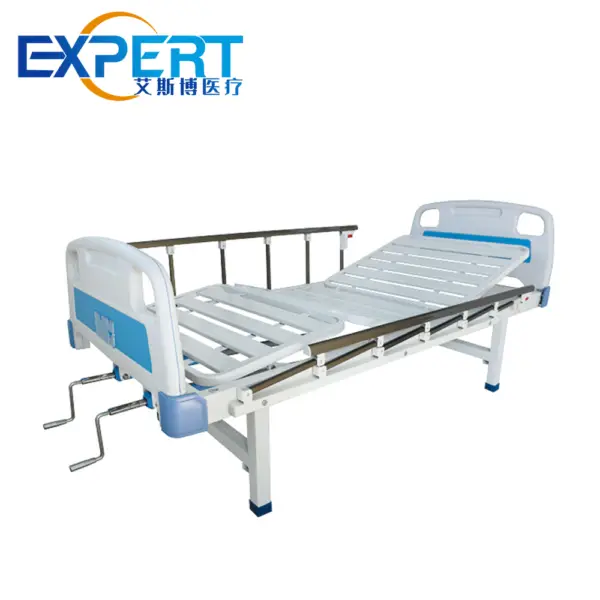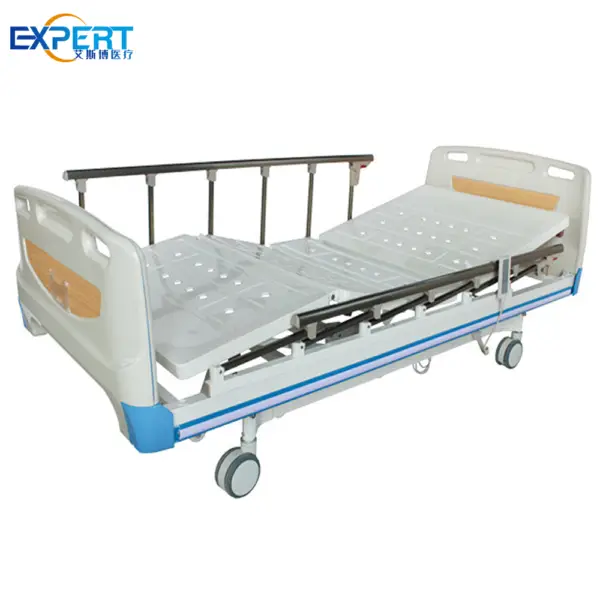Адрес
304 North Cardinal St.
Дорчестер-центр, Массачусетс 02124
Часы работы
С понедельника по пятницу: с 7:00 до 19:00.
Выходные: 10.00 - 17.00
Прежде чем мы погрузимся в контент, я бы хотел, чтобы вы присоединились ко мне на моих платформах социальных сетей, где я делюсь большим количеством идей, взаимодействую с сообществом и публикую обновления. Вот как вы можете связаться со мной:
Фейсбук:https://www.facebook.com/profile.php?id=100071234835011
LinkedIn:https://www.linkedin.com/company/74943205/admin/dashboard/
Ютуб:www.youtube.com/@shandongexpertmedicalequip4695
ТикТок:www.tiktok.com/@expertmedical
Теперь давайте начнем наше путешествие вместе. Надеюсь, вы найдете здесь контент проницательным, интересным и ценным.

По мере старения населения потребность в специализированном медицинском оборудовании становится все более важной. Одним из важнейших элементов оборудования в уходе за пожилыми людьми является больничная кровать с поручнями. Эти кровати предназначены для обеспечения безопасности, комфорта и удобства для пожилых пациентов, что делает их жизненно важным компонентом как в домашних условиях, так и в учреждениях. В этой статье рассматриваются различные причины, по которым больничная кровать с поручнями необходима для ухода за пожилыми людьми, подчеркиваются ее преимущества, особенности и влияние на благополучие пациента.
Больничная кровать с перилами — это тип кровати, используемый в основном в медицинских учреждениях, который включает встроенные защитные перила по бокам. Эти перила предназначены для предотвращения падений, обеспечивают поддержку и облегчают перемещение пациентов. Основные характеристики таких кроватей часто включают:
Одним из основных преимуществ больничной кровати с перилами является повышенная безопасность. Падения представляют значительный риск для пожилых людей, особенно тех, у кого есть проблемы с мобильностью. Наличие боковых перил помогает предотвратить случайные падения, обеспечивая физический барьер, который не дает пациенту скатиться с кровати.
Преимущества безопасности больничных коек с поручнями
| Выгода | Описание |
|---|---|
| Предотвращение падений | Снижает риск падений во время сна или движения. |
| Помощь в передвижении | Оказывает поддержку пациентам при входе в постель и вставании с нее. |
| Экстренная поддержка | Рельсы можно использовать для быстрой помощи пациентам в экстренных случаях. |
Больничные кровати с перилами также могут помочь повысить независимость пожилых пациентов. Обеспечивая поддержку и устойчивость, эти кровати позволяют пациентам с большей легкостью выполнять повседневные действия, например, вставать и ложиться в постель, менять положение и доставать личные вещи.
Эти кровати предлагают регулируемые функции, которые повышают комфорт и удобство. Пациенты могут регулировать положение кровати, чтобы найти наиболее удобную позу для сна или отдыха. Регулируемая высота также позволяет лицам, осуществляющим уход, работать на более эргономичном уровне, снижая напряжение и повышая эффективность предоставления ухода.
Особенности комфорта и удобства больничных кроватей с поручнями
| Характерная черта | Описание |
|---|---|
| Регулируемая высота | Облегчает доступ для лиц, осуществляющих уход, и пациентов. |
| Регулируемое позиционирование | Позволяет пациентам найти удобное положение. |
| Легкий доступ | Поручни обеспечивают поддержку при входе в кровать и вставании с нее. |
Больничные кровати с рельсами предназначены для удовлетворения различных медицинских потребностей. Регулируемые функции позволяют правильно расположить пациентов, что необходимо для медицинских процедур, ухода за ранами и физиотерапии. Устойчивость, обеспечиваемая рельсами, гарантирует, что пациенты могут оставаться в нужном положении без риска поскользнуться или упасть.









В условиях домашнего ухода больничная кровать с перилами может значительно улучшить качество жизни пожилых людей. Она обеспечивает безопасность и поддержку, необходимые людям с проблемами мобильности, позволяя им оставаться дома и получать необходимую им помощь. Опекуны также получают выгоду от эргономичных особенностей, которые делают задачи по уходу более управляемыми.
В домах престарелых больничные кровати с поручнями обычно используются для удовлетворения потребностей жильцов. Эти кровати необходимы для обеспечения безопасности и комфорта людей с разным уровнем мобильности и медицинскими потребностями. Характеристики кровати также облегчают уход и управление со стороны персонала.
Больничные кровати с рельсами также ценны в реабилитационных центрах, где пациенты восстанавливаются после операций, травм или болезней. Регулируемые функции поддерживают физиотерапию и восстановление, позволяя пациентам принимать оптимальное положение и получать необходимую помощь и поддержку.
Использование больничных коек с поручнями в различных условиях
| Параметр | Приложение |
|---|---|
| Уход на дому | Обеспечивает безопасность и поддержку пожилых людей в домашних условиях. |
| Помощь в проживании | Обеспечивает комфорт и удобство ухода для жителей домов престарелых. |
| Реабилитационные центры | Поддерживает восстановление и терапию благодаря регулируемым функциям и защитным поручням. |
При выборе больничной кровати с рельсами важно оценить особые потребности пациента. Учитывайте такие факторы, как мобильность, состояние здоровья и личные предпочтения. Эта оценка поможет определить соответствующие характеристики и настройки, необходимые для оптимального ухода.
Различные больничные кровати поставляются с различными функциями и вариантами регулировки. Оцените доступные варианты и выберите кровать, которая предлагает необходимые регулировки по высоте, позиционированию и конфигурации направляющих. Убедитесь, что кровать отвечает потребностям пациента в безопасности и комфорте.
Убедитесь, что выбранная больничная кровать с поручнями удобно помещается в предполагаемом пространстве. Измерьте область, где будет размещена кровать, и учтите любое дополнительное пространство, необходимое для движения и доступа. Правильное размещение гарантирует, что кровать можно будет использовать эффективно и безопасно.

Проводите регулярные проверки больничной кровати с рельсами, чтобы убедиться, что все компоненты функционируют правильно. Проверяйте наличие любых признаков износа или повреждений и оперативно устраняйте любые проблемы, чтобы поддерживать безопасность и эффективность кровати.
Содержите больничную кровать в чистоте и санированной, чтобы предотвратить инфекции и обеспечить гигиеническую среду. Следуйте рекомендациям производителя по чистке матраса, направляющих и рамы.
Незамедлительно заменяйте любые изношенные или поврежденные детали, чтобы обеспечить постоянную безопасность и функциональность кровати. Регулярное техническое обслуживание и своевременная замена помогают продлить срок службы больничной кровати с рельсами.
А больничная кровать с поручнями является важным компонентом ухода за пожилыми людьми, обеспечивая значительные преимущества с точки зрения безопасности, комфорта и удобства. Его способность предотвращать падения, поддерживать независимость и удовлетворять медицинские потребности делает его ценным активом в домашнем уходе, домах престарелых и реабилитационных центрах. Понимая преимущества и особенности больничной кровати с перилами и обеспечивая надлежащее обслуживание, лица, осуществляющие уход, могут улучшить качество жизни пожилых людей и обеспечить эффективный уход.
Каковы основные преимущества больничная кровать с поручнями?
К основным преимуществам больничной кровати с перилами относятся повышенная безопасность за счет предотвращения падений, большая независимость пациентов, повышенный комфорт за счет регулируемых функций, а также удобство при медицинском уходе и процедурах.
Как перила больничных кроватей помогают предотвратить падения?
Поручни больничных кроватей обеспечивают физический барьер, который помогает предотвратить случайное скатывание пациентов с кровати. Они также обеспечивают поддержку пациентов при входе и выходе из кровати, снижая риск падений.
Может ли больничная кровать с поручнями быть адаптированы к различным потребностям пациентов?
Да, большинство больничных кроватей с рельсами оснащены регулируемыми функциями, которые позволяют регулировать высоту и положение. Эта адаптивность гарантирует, что кровать может быть настроена в соответствии с конкретными потребностями и предпочтениями пациента.
Как следует ухаживать за больничной кроватью с перилами?
Больничную кровать с поручнями следует регулярно осматривать на предмет износа или повреждений, чистить и дезинфицировать в соответствии с рекомендациями производителя, а также своевременно заменять любые изношенные или поврежденные детали, чтобы обеспечить постоянную безопасность и функциональность.
Где находятся больничные койки с поручнями обычно используется?
Больничные кровати с поручнями обычно используются в учреждениях по уходу на дому, домах престарелых и реабилитационных центрах. Они необходимы для обеспечения безопасности, комфорта и поддержки пожилых людей и пациентов с различными медицинскими потребностями.
